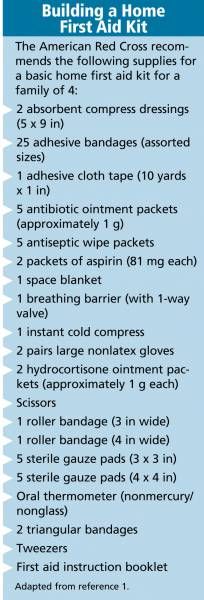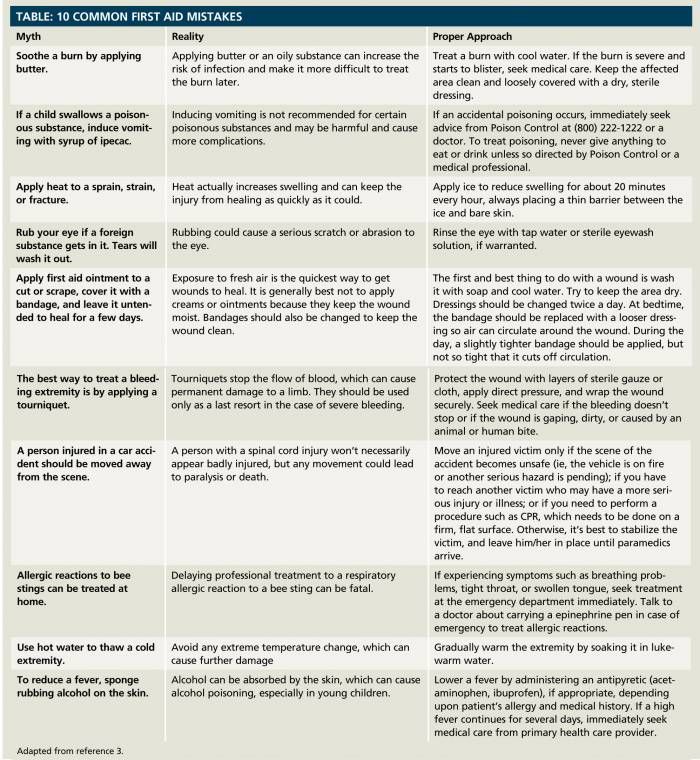Publication
Article
Pharmacy Times
Be Prepared: First Aid Kit Basics
Author(s):
Patients can be ready for minor emergencies by compiling a first aid kit that meets their specific needs.
Patients can be ready for minor emergencies by compiling a first aid kit that meets their specific needs.
It is prudent to always have the necessary medical supplies on hand in case of an unexpected injury, accident, or illness. Many drugstores sell ready-made first aid kits,

but first aid kits can also be tailored to specific medical needs or activities, such as boating, hiking, or camping.1
The American Red Cross suggests that everyone should have a first aid kit in the home and in the car. Home first aid kits generally contain basic supplies, such as bandages and topical antibiotics to treat common minor problems such as cuts, scrapes, burns, abrasions, sprains, stings, and strains.2 Some home kits also contain analgesics, antihistamines, anti-inflammatory agents, and antipyretics.
First aid kits designed for travel should also be more comprehensive because drugstores may not always be accessible.1,2 Comprehensive kits may contain pharmacologic agents to alleviate nasal congestion, fever, cough, and sore throat, as well as allergies and gastrointestinal issues.2 Pharmacists can provide patients with a list of recommended items for a basic home first aid kit.
First aid kits should be stored in sturdy, water-resistant containers whenever possible and should always be kept out of young children’s reach. It is important to routinely check the expiration dates of first aid kit contents and replenish supplies as needed. If the kit is for both adults and children, medications in the first aid kit should include both adult formulations and pediatric formulations to ensure appropriate dosing. It is also important to have the number to the Poison Control Center (800-222-1222) readily available in case of emergency.
Patients should be reminded to always call 911 in case of a medical emergency, but having a first aid kit on hand may help to treat injuries promptly and minimize further complications. During counseling, patients should be encouraged to have a first aid kit available at all times and to enroll in a first aid class in order to learn how to properly respond in emergency situations. Patients should also be advised to use only reputable sources of first aid information and to educate themselves regarding common first aid myths (Table).

Recommended Items for a Travel First Aid Kit
The following items are recommended for inclusion in a travel first aid kit. These items are readily available at many drugs stores and kits should be tailored for specific patients after considering medical history and needs.
• First aid instruction book
• Adhesive tape
• Sterile gauze pads (4 x 4 in)
• Topical anesthetic spray
• Antacids
• Analgesics/antipyretics such as acetaminophen, ibuprofen, or naproxen
• Antidiarrheals
• Antihistamine cream
• Small bottle liquid soap
• Aspirin for mild pain or heart attack
• Adhesive bandages (various sizes)
• Finger splints
• Diphenhydramine or other oral antihistamines
• Topical hydrocortisone
• Topical antihistamines
• Cigarette lighter to sterilize instruments and to be able to start a fire in the wilderness
• Cough medications such as dextromethorphan or guaifenesin
• Dental kit
• Nonlatex gloves
• Small flashlight
• Insect repellant
• Small Swiss Army-type knife
• Moleskin
• Nasal spray decongestant
• Non-adhesive wound pads
• Topical antibiotic ointment
• Oral decongestant
• Oral lozenges for sore throat pain
• Personal medications (enough for the trip duration and perhaps a couple of extra in case of delays) and items (for example, a cane or knee braces if needed)
• Re-sealable plastic bags
• Safety pins
• Scissors
• Sterile eye wash
• Sunscreen
• Thermometer
• Tweezers
• A list containing patient medical history, current medications, doctors, insurance information, and emergency contacts
Ms. Terrie is a clinical pharmacy writer based in Haymarket, Virginia.
References
1. Anatomy of a First Aid Kit. American Red Cross website. www.redcross.org/services/hss/lifeline/fakit.html. Accessed June 29, 2012.
2. Fuerst Ron. First Aid Kits. eMedicine website. www.emedicinehealth.com/first_aid_kits/article_em.htm. Accessed June 29, 2012.
3. Ten Common First Aid Mistakes. American Red Cross website. www.redcross.org/email/safetynet/v1n9/firstaid.asp. Accessed June 29, 2012.
4. First Aid Kit. Medline Plus website. www.nlm.nih.gov/medlineplus/ency/article/001958.htm. Accessed June 29, 2012.
5. First-aid kits: Stock supplies that can save lives. Mayo Clinic website. www.mayoclinic.com/health/first-aid-kits/FA00067/METHOD=print. Accessed June 29, 2012.
6. First Aid Kit. Nemours Foundation website. http://kidshealth.org/parent/firstaid_safe/home/firstaid_kit.html?tracking=83967_G#cat31. Accessed June 29, 2012.
7. Home First Aid Kits. American College of Emergency Physicians website. www.emergencycareforyou.org/assets/0/74/138/214/314/b6a3876b-49dd-4fcc-bee6-01d3bef1116b.pdf. Accessed June 29, 2012.







